The Latin Church in Norman Italy by G. A. Loud
First published in 2007, this was the first significant study of the incorporation of the Church in southern Italy into the mainstream of Latin Christianity during the eleventh and twelfth centuries. Professor G. A. Loud examines the relationship between Norman rulers, south Italian churchmen and the external influence of the new 'papal monarchy'. He discusses the impact of the creation of the new kingdom of Sicily in 1130; the tensions that arose from the papal schism of that era; and the religious policy and patronage of the new monarchs. He also explores the internal structures of the Church, both secular and monastic, and the extent and process of Latinisation within the Graecophone areas of the mainland and on the island of Sicily, where at the time of the Norman conquest the majority of the population was Muslim. This is a major contribution to the political, religious and cultural history of the Central Middle Ages.
Sanctity and Pilgrimage in Medieval Southern Italy, 1000–1200 by Paul Oldfield
 Southern Italy's strategic location at the crossroads of the Mediterranean gave it a unique position as a frontier for the major religious faiths of the medieval world, where Latin Christian, Greek Christian and Muslim communities coexisted. In this study, the first to offer a comprehensive analysis of sanctity and pilgrimage in southern Italy between 1000 and 1200, Paul Oldfield presents a fascinating picture of a politically and culturally fragmented land which, as well as hosting its own important relics as important pilgrimage centres, was a transit point for pilgrims and commercial traffic. Drawing on a diverse range of sources from hagiographical material to calendars, martyrologies, charters and pilgrim travel guides, the book examines how sanctity functioned at this key cultural crossroads and, by integrating the analysis of sanctity with that of pilgrimage, offers important new insights into society, cross-cultural interaction and faith in the region and across the medieval world.
Southern Italy's strategic location at the crossroads of the Mediterranean gave it a unique position as a frontier for the major religious faiths of the medieval world, where Latin Christian, Greek Christian and Muslim communities coexisted. In this study, the first to offer a comprehensive analysis of sanctity and pilgrimage in southern Italy between 1000 and 1200, Paul Oldfield presents a fascinating picture of a politically and culturally fragmented land which, as well as hosting its own important relics as important pilgrimage centres, was a transit point for pilgrims and commercial traffic. Drawing on a diverse range of sources from hagiographical material to calendars, martyrologies, charters and pilgrim travel guides, the book examines how sanctity functioned at this key cultural crossroads and, by integrating the analysis of sanctity with that of pilgrimage, offers important new insights into society, cross-cultural interaction and faith in the region and across the medieval world.
City and Community in Norman Italy by Paul Oldfield
 This study of urban society in twelfth-century mainland Norman Italy examines the self-governing role of urban communities and explores their social ordering, identities and communal activities. Drawing on charters, chronicles, annals and other sources, Paul Oldfield uncovers notable continuities in a range of cities across southern Italy throughout a period of regime change and disruption. Unlike traditional interpretations which suggest that the Normans, and the creation of a monarchy in 1130, stifled urban development, this book suggests that south Italian urban communities were still able to enjoy a level of autonomy under the Norman monarchy. By emphasising the fluidity of the social structures and groups found in these cities, alongside the influential role of both the Church and civic consciousness, the author sheds light on the multi-layered complexity of the urban communities of Norman Italy and provides a more balanced comparison with the cities of northern Italy.
This study of urban society in twelfth-century mainland Norman Italy examines the self-governing role of urban communities and explores their social ordering, identities and communal activities. Drawing on charters, chronicles, annals and other sources, Paul Oldfield uncovers notable continuities in a range of cities across southern Italy throughout a period of regime change and disruption. Unlike traditional interpretations which suggest that the Normans, and the creation of a monarchy in 1130, stifled urban development, this book suggests that south Italian urban communities were still able to enjoy a level of autonomy under the Norman monarchy. By emphasising the fluidity of the social structures and groups found in these cities, alongside the influential role of both the Church and civic consciousness, the author sheds light on the multi-layered complexity of the urban communities of Norman Italy and provides a more balanced comparison with the cities of northern Italy.
Crime and Justice in Late Medieval Italy by Trevor Dean
 In this important study, Trevor Dean examines the history of crime and criminal justice in Italy from the mid-thirteenth to the end of the fifteenth century. The book contains studies of the most frequent types of prosecuted crime such as violence, theft and insult, along with the rarely prosecuted sorcery and sex crimes. Drawing on a diverse and innovative range of sources, including legislation, legal opinions, prosecutions, chronicles and works of fiction, Dean demonstrates how knowledge of the history of criminal justice can illuminate our wider understanding of the Middle Ages. Issues and instruments of criminal justice reflected the structure and operation of state power; they were an essential element in the evolution of cities and they provided raw material for fictions. Furthermore, the study of judicial records provides insight into a wide range of social situations, from domestic violence to the oppression of ethnic minorities.
In this important study, Trevor Dean examines the history of crime and criminal justice in Italy from the mid-thirteenth to the end of the fifteenth century. The book contains studies of the most frequent types of prosecuted crime such as violence, theft and insult, along with the rarely prosecuted sorcery and sex crimes. Drawing on a diverse and innovative range of sources, including legislation, legal opinions, prosecutions, chronicles and works of fiction, Dean demonstrates how knowledge of the history of criminal justice can illuminate our wider understanding of the Middle Ages. Issues and instruments of criminal justice reflected the structure and operation of state power; they were an essential element in the evolution of cities and they provided raw material for fictions. Furthermore, the study of judicial records provides insight into a wide range of social situations, from domestic violence to the oppression of ethnic minorities.
The Decline and Fall of Medieval Sicily: Politics, Religion, and Economy in the Reign of Frederick III, 1296–1337 by Clifford R. Backman
 This 1995 book is a detailed study of Sicilian life in the reign of Frederick III (1296–1337), a period which saw Sicily reduced from a bustling and prosperous Mediterranean emporium to a poor backwater torn apart by violence. The relative economic and social backwardness of Sicily within modern Italy has attracted considerable scholarly attention. Attempts to explain its ingrained poverty and civil strife usually blame either the legacy of two thousand years of colonisation by rapacious foreigners or the inherent weaknesses in the island itself and its people. More recently a model of 'economic dualism' has pointed to basic structural flaws in the economic relations that were established between the island and its continental trading partners from the twelfth century onwards. This book, by focusing on Frederick III's crucial reign, argues that there were many more things 'wrong' with Sicilian life than just the shape of its overseas trade relations.
This 1995 book is a detailed study of Sicilian life in the reign of Frederick III (1296–1337), a period which saw Sicily reduced from a bustling and prosperous Mediterranean emporium to a poor backwater torn apart by violence. The relative economic and social backwardness of Sicily within modern Italy has attracted considerable scholarly attention. Attempts to explain its ingrained poverty and civil strife usually blame either the legacy of two thousand years of colonisation by rapacious foreigners or the inherent weaknesses in the island itself and its people. More recently a model of 'economic dualism' has pointed to basic structural flaws in the economic relations that were established between the island and its continental trading partners from the twelfth century onwards. This book, by focusing on Frederick III's crucial reign, argues that there were many more things 'wrong' with Sicilian life than just the shape of its overseas trade relations.
An Island for Itself: Economic Development and Social Change in Late Medieval Sicily by Stephan R. Epstein
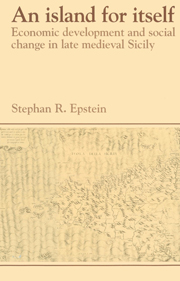 This study of late medieval Sicily develops a critique of theories of dependence through trade, and a new interpretation of the late medieval economy. It thus addresses current debates on the origins of modern Italian economic dualism, and on the transition from feudalism to capitalism in early modern Europe. Dr Epstein argues that economic development during this period was shaped largely by regional political and institutional structures which regulated access to markets. Following the Black Death, many institutional and social constraints on commercialization were relaxed throughout western Europe as a result of social conflict and demographic change. Peasants became more commercialized; economic growth occurred through regional integration and specialization. The Sicilian economy also expanded and became increasingly export-oriented. although only a small proportion of its output was shipped abroad before 1500. Late medieval Sicily is thus shown to have been neither underdeveloped nor dependent on foreign manufactures and trade.
This study of late medieval Sicily develops a critique of theories of dependence through trade, and a new interpretation of the late medieval economy. It thus addresses current debates on the origins of modern Italian economic dualism, and on the transition from feudalism to capitalism in early modern Europe. Dr Epstein argues that economic development during this period was shaped largely by regional political and institutional structures which regulated access to markets. Following the Black Death, many institutional and social constraints on commercialization were relaxed throughout western Europe as a result of social conflict and demographic change. Peasants became more commercialized; economic growth occurred through regional integration and specialization. The Sicilian economy also expanded and became increasingly export-oriented. although only a small proportion of its output was shipped abroad before 1500. Late medieval Sicily is thus shown to have been neither underdeveloped nor dependent on foreign manufactures and trade.
Land and Power in Late Medieval Ferrara: The Rule of the Este, 1350-1450 by Trevor Dean
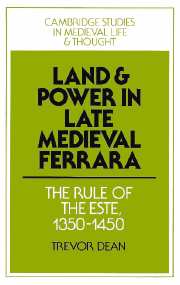 Among the many states of late medieval Italy, one stands out for its unfamiliarity to an English audience and for its neglect in historical research: that of the Este family, lords (later Dukes) of the cities of Ferrara, Modena and Reggio in northern Italy. This book is the first modern attempt to provide a detailed analysis of the political structure of this state based on archive sources. Much of the book is concerned with the ways by which the Este used their vast landed resources in and around Ferrara to build up and reinforce their personal political authority both within and outside their dominions. Among the major themes examined are the continuing presence of political feudalism in the relations between the Este and their supporters, the place of the court in Ferrarese noble society, and the violent imposition of Este authority over the powerful nobles of the Apennine hills.
Among the many states of late medieval Italy, one stands out for its unfamiliarity to an English audience and for its neglect in historical research: that of the Este family, lords (later Dukes) of the cities of Ferrara, Modena and Reggio in northern Italy. This book is the first modern attempt to provide a detailed analysis of the political structure of this state based on archive sources. Much of the book is concerned with the ways by which the Este used their vast landed resources in and around Ferrara to build up and reinforce their personal political authority both within and outside their dominions. Among the major themes examined are the continuing presence of political feudalism in the relations between the Este and their supporters, the place of the court in Ferrarese noble society, and the violent imposition of Este authority over the powerful nobles of the Apennine hills.
The New World in Early Modern Italy, 1492–1750 eds: Elizabeth Horodowich and Lia Markey
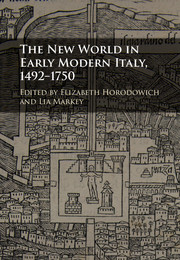 Italians became fascinated by the New World in the early modern period. While Atlantic World scholarship has traditionally tended to focus on the acts of conquest and the politics of colonialism, these essays consider the reception of ideas, images and goods from the Americas in the non-colonial states of Italy. Italians began to venerate images of the Peruvian Virgin of Copacabana, plant tomatoes, potatoes, and maize, and publish costume books showcasing the clothing of the kings and queens of Florida, revealing the powerful hold that the Americas had on the Italian imagination. By considering a variety of cases illuminating the presence of the Americas in Italy, this volume demonstrates how early modern Italian culture developed as much from multicultural contact - with Mexico, Peru, Brazil, and the Caribbean - as it did from the rediscovery of classical antiquity.
Italians became fascinated by the New World in the early modern period. While Atlantic World scholarship has traditionally tended to focus on the acts of conquest and the politics of colonialism, these essays consider the reception of ideas, images and goods from the Americas in the non-colonial states of Italy. Italians began to venerate images of the Peruvian Virgin of Copacabana, plant tomatoes, potatoes, and maize, and publish costume books showcasing the clothing of the kings and queens of Florida, revealing the powerful hold that the Americas had on the Italian imagination. By considering a variety of cases illuminating the presence of the Americas in Italy, this volume demonstrates how early modern Italian culture developed as much from multicultural contact - with Mexico, Peru, Brazil, and the Caribbean - as it did from the rediscovery of classical antiquity.
The Duke's Assassin: Exile and Death of Lorenzino de' Medici by Stefano Dall'Aglio and Donald Weinstein
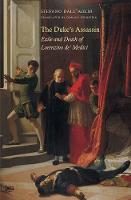 Stefano Dall’Aglio sheds new light on the notorious Florentine Lorenzino de’ Medici (also known as Lorenzaccio) and on two of the most infamous assassinations of Italian Renaissance history. In 1537 Lorenzino changed the course of history by murdering Alessandro de’ Medici, first duke of Florence, and paving the way for the accession of the new duke, Cosimo I. In 1548 Lorenzino was killed in Venice in revenge for the assassination he had committed. Basing his work on extensive research in the historical archives of Florence and Simancas, Dall’Aglio reconstructs the events surrounding these murders and involving the Medici, their loyalists, the Florentine republican exiles, and some of the most powerful sovereigns of the time. The first publication in a century, and the first work in English, to examine the life of Lorenzino de’ Medici, this fascinating revisionist history is as gripping as a detective novel, as Dall’Aglio unravels a 500-year-old mystery, revealing that behind the bloody death of the duke’s assassin there was the Emperor Charles V.
Stefano Dall’Aglio sheds new light on the notorious Florentine Lorenzino de’ Medici (also known as Lorenzaccio) and on two of the most infamous assassinations of Italian Renaissance history. In 1537 Lorenzino changed the course of history by murdering Alessandro de’ Medici, first duke of Florence, and paving the way for the accession of the new duke, Cosimo I. In 1548 Lorenzino was killed in Venice in revenge for the assassination he had committed. Basing his work on extensive research in the historical archives of Florence and Simancas, Dall’Aglio reconstructs the events surrounding these murders and involving the Medici, their loyalists, the Florentine republican exiles, and some of the most powerful sovereigns of the time. The first publication in a century, and the first work in English, to examine the life of Lorenzino de’ Medici, this fascinating revisionist history is as gripping as a detective novel, as Dall’Aglio unravels a 500-year-old mystery, revealing that behind the bloody death of the duke’s assassin there was the Emperor Charles V.
Markets and Marketplaces in Medieval Italy, c. 1100 to c. 1440 by Dennis Romano
 Cathedrals and civic palaces stand to this day as symbols of the dynamism and creativity of the city-states that flourished in Italy during the Middle Ages. Markets and Marketplaces in Medieval Italy argues that the bustling yet impermanent sites of markets played an equally significant role, not only in the economic life of the Italian communes, but in their political, social, and cultural life as well. Drawing on a range of evidence from cities and towns across northern and central Italy, Dennis Romano explores the significance of the marketplace as the symbolic embodiment of the common good; its regulation and organization; the ethics of economic exchange; and how governments and guilds sought to promote market values. With a special focus on the spatial, architectural, and artistic elements of the marketplace, Romano adds new dimensions to our understanding of the evolution of the market economy and the origins of commercial capitalism and Renaissance individualism.
Cathedrals and civic palaces stand to this day as symbols of the dynamism and creativity of the city-states that flourished in Italy during the Middle Ages. Markets and Marketplaces in Medieval Italy argues that the bustling yet impermanent sites of markets played an equally significant role, not only in the economic life of the Italian communes, but in their political, social, and cultural life as well. Drawing on a range of evidence from cities and towns across northern and central Italy, Dennis Romano explores the significance of the marketplace as the symbolic embodiment of the common good; its regulation and organization; the ethics of economic exchange; and how governments and guilds sought to promote market values. With a special focus on the spatial, architectural, and artistic elements of the marketplace, Romano adds new dimensions to our understanding of the evolution of the market economy and the origins of commercial capitalism and Renaissance individualism.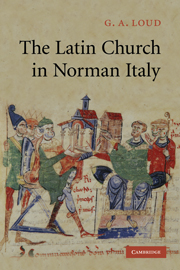

No comments:
Post a Comment